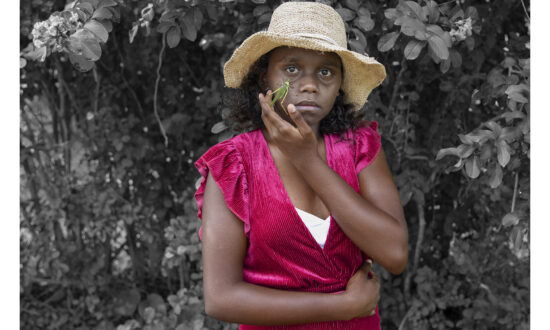The display, Close Contact, borrows its name from Vincent Namatjira’s overall Ramsay winner from 2019, which is shown with Pierre Mukeba’s Ride to Church, the 2019 Lipman Karas People’s Choice winner. Hung alongside key historical and contemporary works from AGSA’s collection, they connect artists across time who have negotiated the complex histories of the occupation of Australia, Africa and Aotearoa New Zealand. The display speaks to the legacy of colonisation and the dual histories of nations with colonial pasts, with the aim of revealing and considering the complexities of these shared pasts.
Many visitors to the Gallery will remember Vincent Namatjira’s winning sculptural painting Close Contact. This double-sided work features a self-portrait of the artist back-to-back with a portrait of the navigator–explorer James Cook, based on his likeness in the well-known Emanuel Phillips Fox painting Landing of Captain Cook at Botany Bay, 1770. By wittily positioning the two men together, the artist plays with the heroic image of Cook. In much the same way as wooden cut-out figures at fun fairs and carnivals encourage people to place their heads into the frame for souvenir photos, Gallery visitors frequently take ‘selfies’ with Close Contact, inadvertently placing themselves into a conversation about Australia’s double-sided history.


Above: The two sides of Vincent Namatjira’s ‘Close Contact’. Supplied images
Ride to church captures a scene of everyday Central African family life, in which six people are piled onto a small motorcycle on their way to church. Although his Congolese homeland has faced conflict, Pierre Mukeba recalls a joyous moment that emphasises family and resilience. Mukeba uses drawing and vibrant fabrics (sourced by his mother during return visits to the Congo) to define the figures in this work and to create a sense of movement on the motorcycle as it zips along. These kaleidoscopic fabrics have cross-cultural roots: their distinctive patterns, with a unique local iconography and vernacular, are a synthesis of Africa’s long tradition of textile manufacture and the resist-dyeing techniques introduced through colonial trade routes.
Like Close Contact and Ride to Church, each of the other works in the display expresses the artist’s sense of social and political inquiry as well as their personal experiences. Several favourites from the Gallery collection figure in this dialogue, as does a major new acquisition, Daniel Boyd’s Untitled (TBOMB).
Boyd’s monumental diptych is the first work by an Aboriginal artist to be acquired through the James & Diana Ramsay Fund, which is also the supporter of the Ramsay Art Prize. Boyd, a descendant of the Kudjila and Gangalu people of central Queensland and of Pacific Islander people, depicts a humble picnic, which he has based on a family photograph taken before he was born. The scene is filled with children and adults surrounded by balloons in the colours of the Aboriginal flag. This modest scene is a universal experience, but it provokes viewers to rethink eurocentric norms. By positioning his Aboriginal family in a setting where a ‘typical’ European-Australian family might commonly be seen, the familiarity of this scene encourages us to consider our shared human experiences and histories.

Get InReview in your inbox – free each Saturday. Local arts and culture – covered.
Thanks for signing up to the InReview newsletter.
The work also references and reinvents painting traditions in art history. To create the scene, Boyd has dotted glue across the canvas and then painted over the dots with synthetic polymer paint. While this echoes the dotting often found in Aboriginal art, the technique also recalls the method used by nineteenth-century pointillist painters to create an image by using dots of colour. The human eye and brain make sense of what they see, and indeed the mind constructs the scene even where there may be gaps. In Untitled (TBOMB), the dark background can remind us of the gaps in our personal and collective histories, while the dots act as lenses or portals that allow us to visualise our shared history through the familiarity of a scene recognisable to us all.
With just over 10 works of art, Close Contact represents a small presentation but a larger conversation. It reminds us that for many countries, such as ours, colonial rule still affects people’s lives and colonial histories remain ever-present.

‘Close Contact’ at AGSA. Supplied image
As the 2021 Ramsay Art Prize brings forth new winners and new dialogues, the awarded works from the 2019 exhibition are still contributing to a vocal and vital discussion.
Close Contact was due to be on display until July 11, but it has been extended.
Gloria Strzelecki is Associate Curator of Aboriginal and Torres Strait Islander Art at AGSA.
This article is part of InDaily’s Off the Wall series highlighting gallery treasures.
Support local arts journalism
Your support will help us continue the important work of InReview in publishing free professional journalism that celebrates, interrogates and amplifies arts and culture in South Australia.
Donate Here




